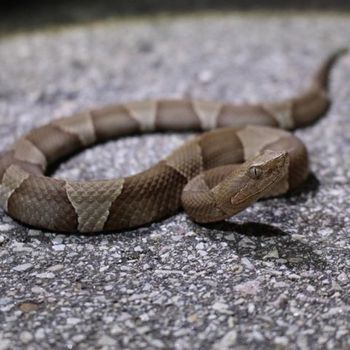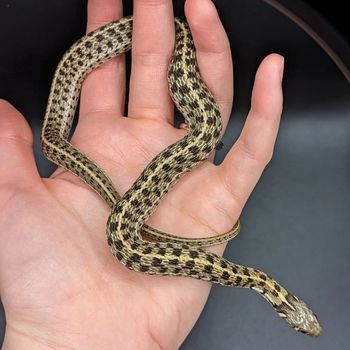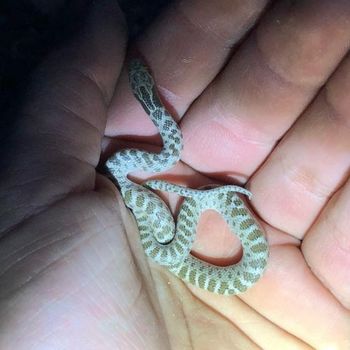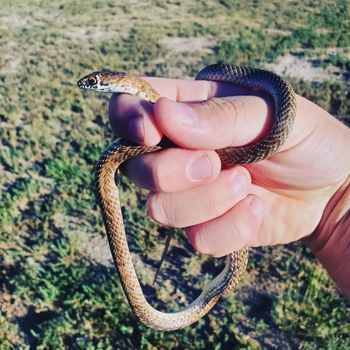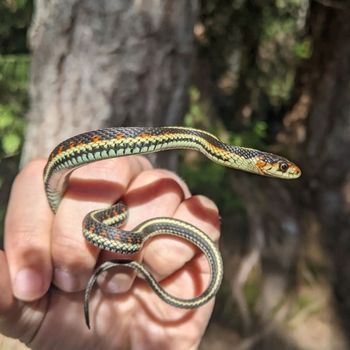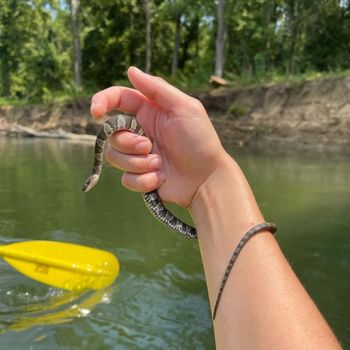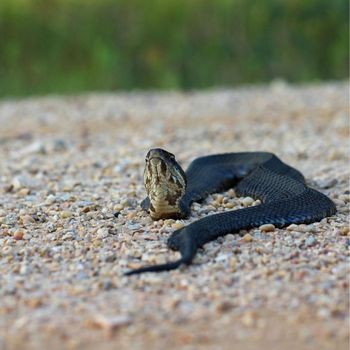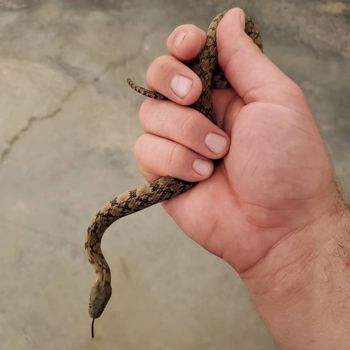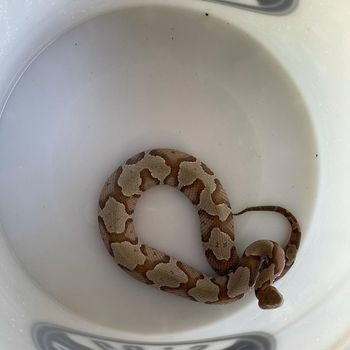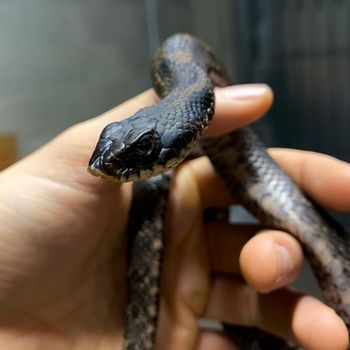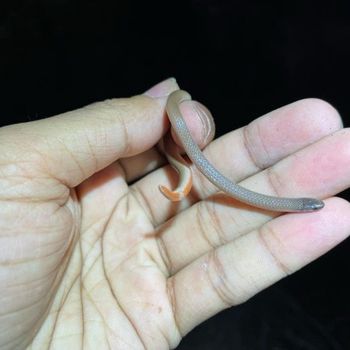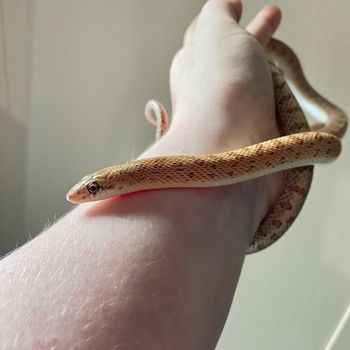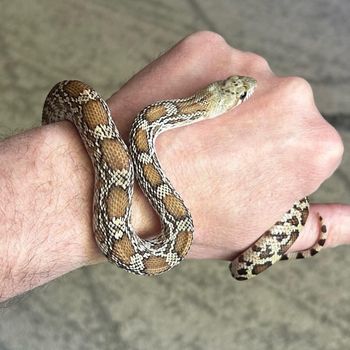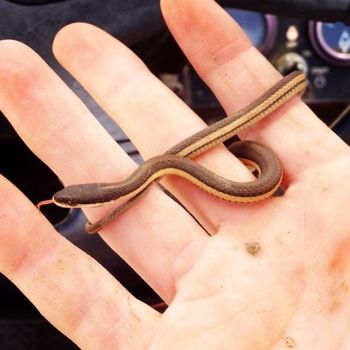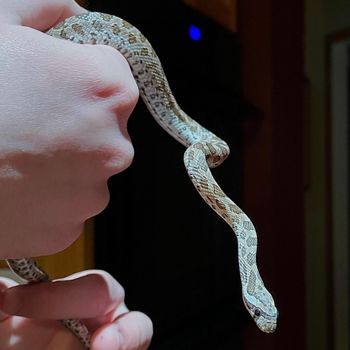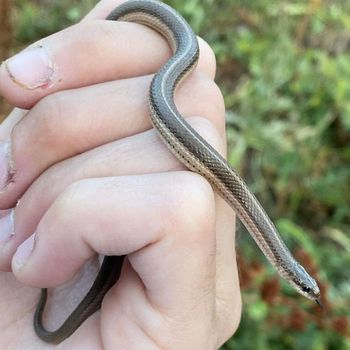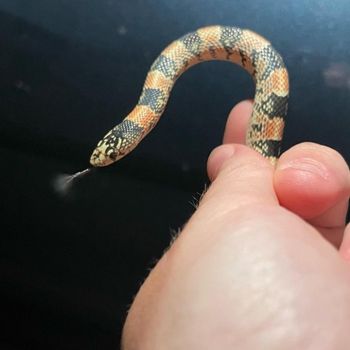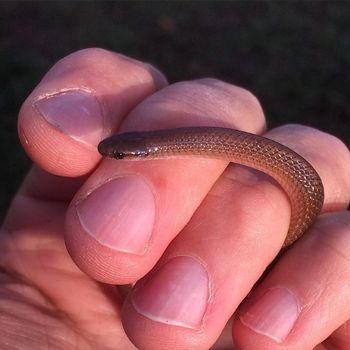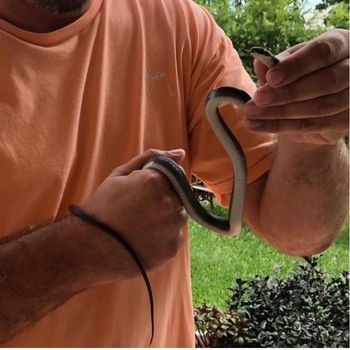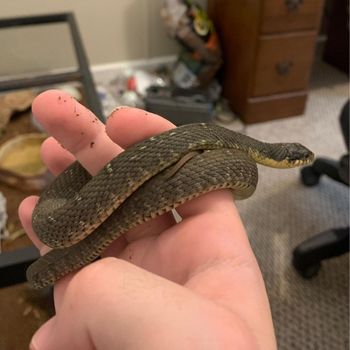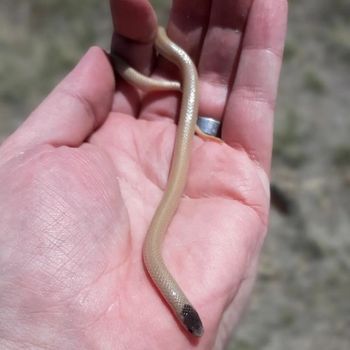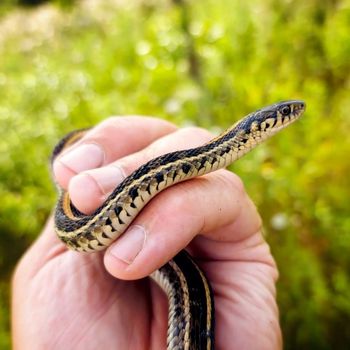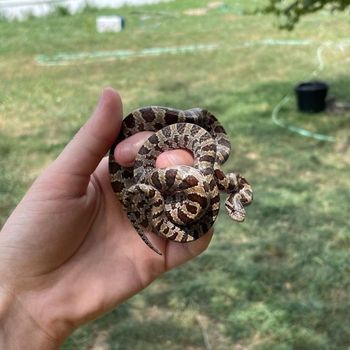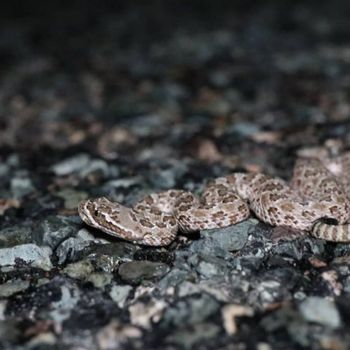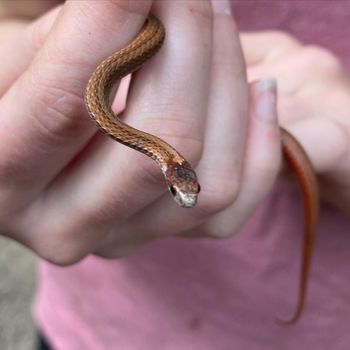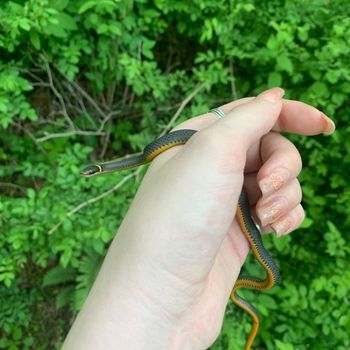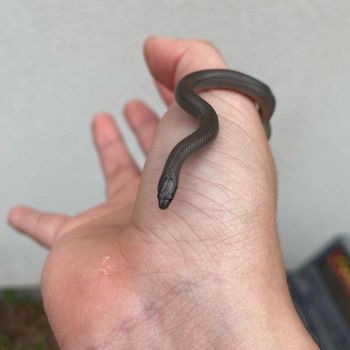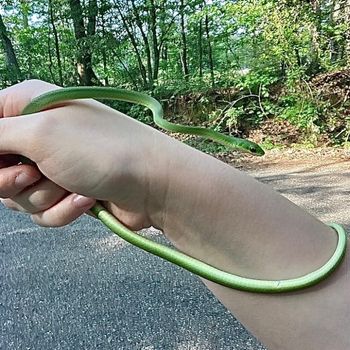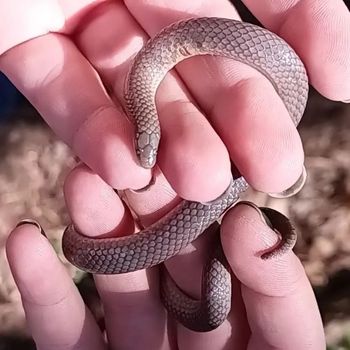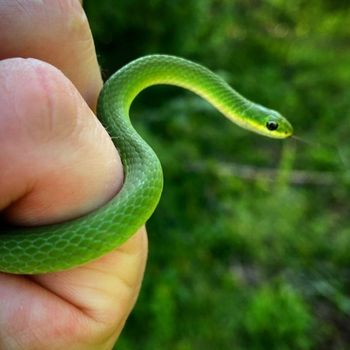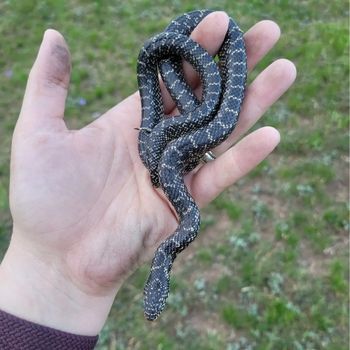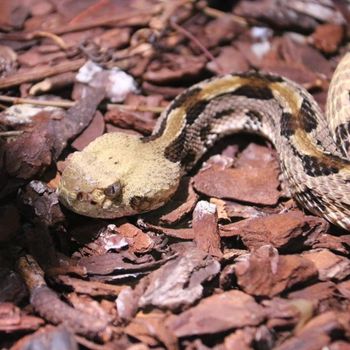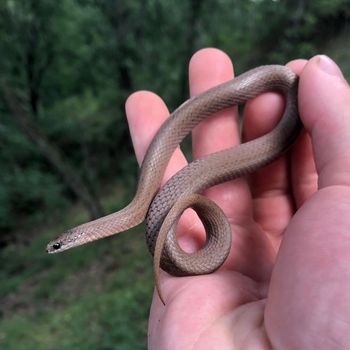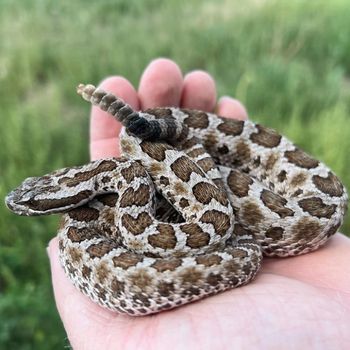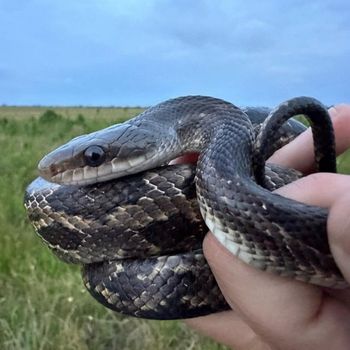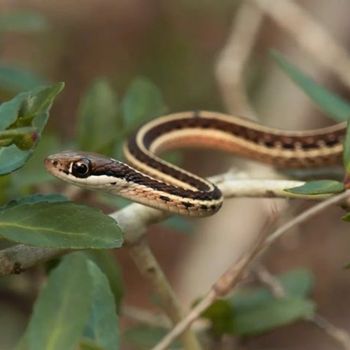Snakes in Kansas: Sunflower State Serpents
Did you know that Kansas is a snake lover’s paradise? That’s right! The beautiful state of Kansas is teeming with slithering reptiles, and we’re excited to share that with you.
In fact, the Sunflower State is home to a jaw-dropping 40 species of snakes! From harmful venomous snakes to harmless and fascinating species, our lovely Kansas has got you covered. Among these, you’ll find four venomous species, including the eastern copperhead and the western massasauga rattlesnake, both to be avoided in the wild. Thankfully, most are non-venomous and contribute significantly to the ecosystem, much like their florida native snake species counterparts. Whether you’re a herpetology enthusiast or simply curious, Kansas offers endless opportunities for snake observation and appreciation.
So, put on your explorer’s hat and join us as we embark on a scaly, slithery adventure, diving into the captivating world of Kansas’s serpents. Ready? Let’s go!
| # | Name | Details | Image |
| 1 | Broad-banded Copperhead (Agkistrodon contortrix laticinctus) |
| 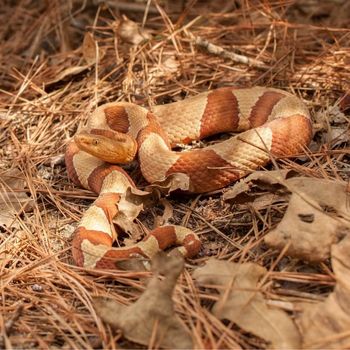 |
| 2 | Checkered Garter Snake (Thamnophis marcianus) |
| 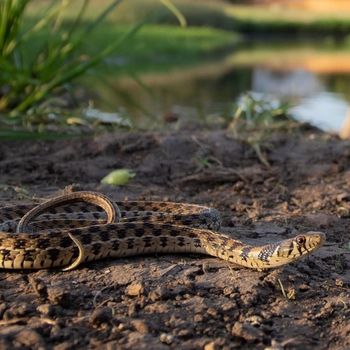 |
| 3 | Chihuahuan Nightsnake (Hypsiglena jani) |
| 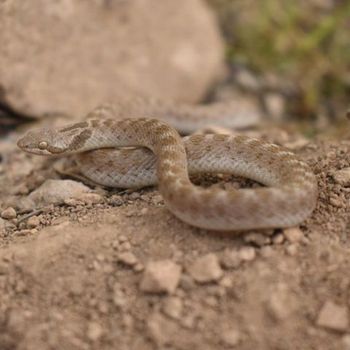 |
| 4 | Coachwhip Snake (Masticophis flagellum) |
| 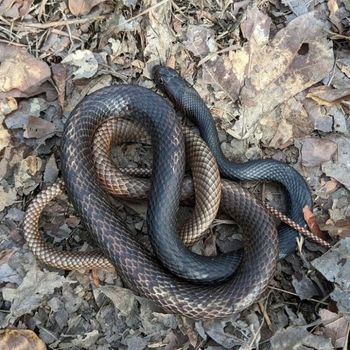 |
| 5 | Common Garter Snake (Thamnophis sirtalis) |
| 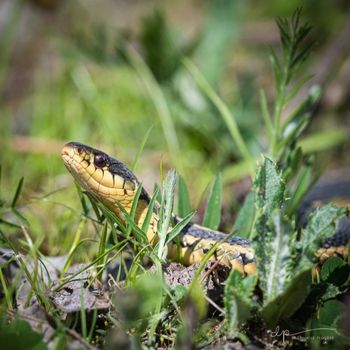 |
| 6 | Common Water Snake (Nerodia sipedon) |
| 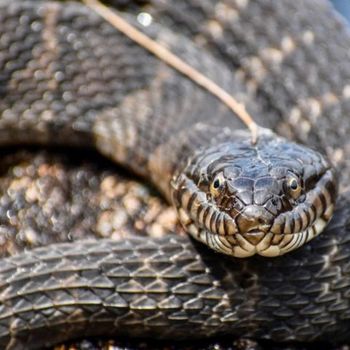 |
| 7 | Cottonmouth (Agkistrodon piscivorus) |
| 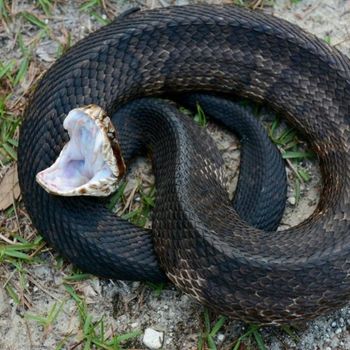 |
| 8 | Dekay’s Brownsnake (Storeria dekayi) |
| 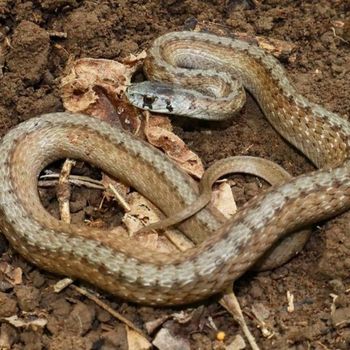 |
| 9 | Diamond-backed Water Snake (Nerodia rhombifer) |
| 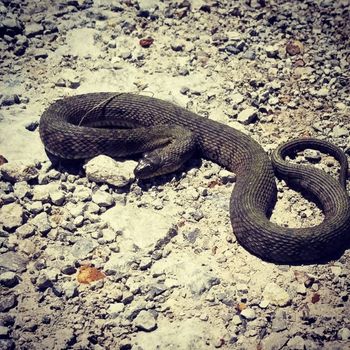 |
| 10 | Eastern Copperhead (Agkistrodon contortrix) |
| 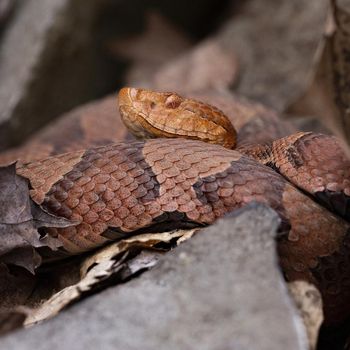 |
| 11 | Eastern Hog-nosed Snake (Heterodon platirhinos) |
| 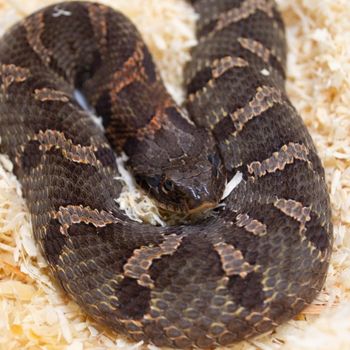 |
| 12 | Eastern Milksnake (Lampropeltis triangulum) |
|  |
| 13 | Flat-headed Snake (Tantilla gracilis) |
| 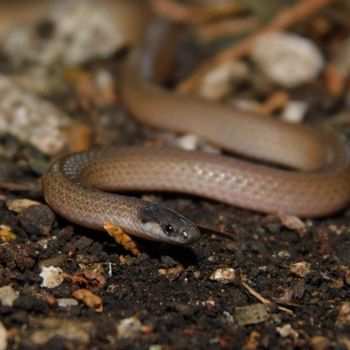 |
| 14 | Glossy Snake (Arizona elegans) |
|  |
| 15 | Gophersnake (Pituophis catenifer) |
| 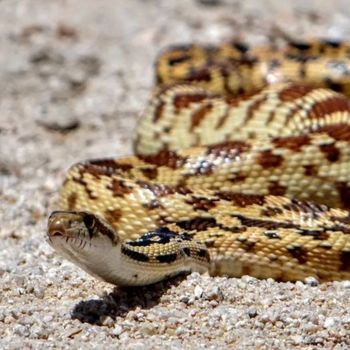 |
| 16 | Graham’s Crayfish Snake (Regina grahamii) |
| 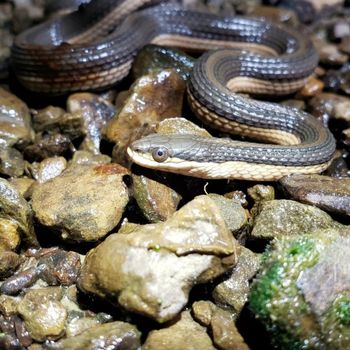 |
| 17 | Great Plains Rat Snake (Pantherophis emoryi) |
| 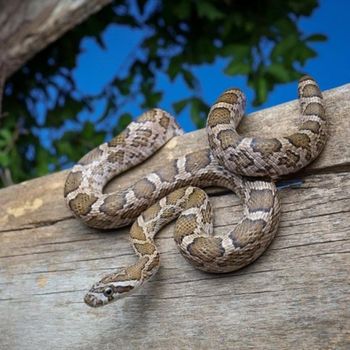 |
| 18 | Lined Snake (Tropidoclonion lineatum) |
| 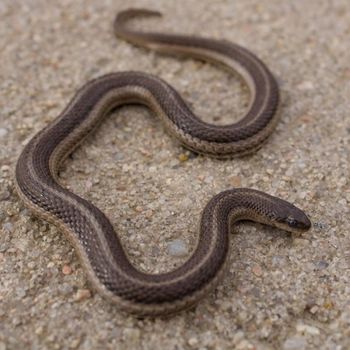 |
| 19 | Long-Nosed Snake (Rhinocheilus lecontei) |
| 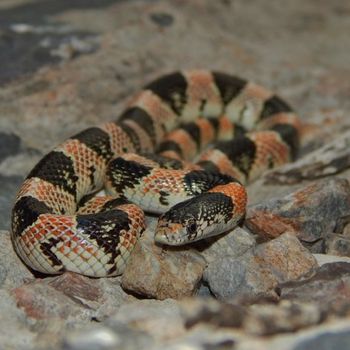 |
| 20 | New Mexico Threadsnake (Leptotyphlops dissectus) |
| 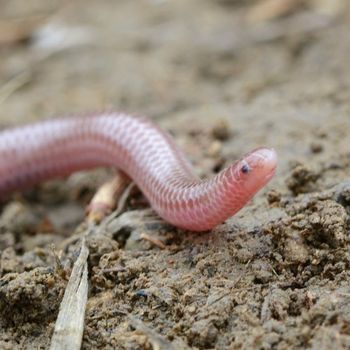 |
| 21 | North American Racer (Coluber constrictor) |
| 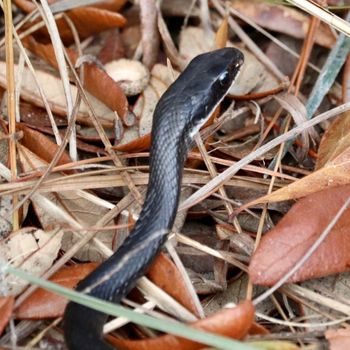 |
| 22 | Plain-bellied Watersnake (Nerodia erythrogaster) |
| 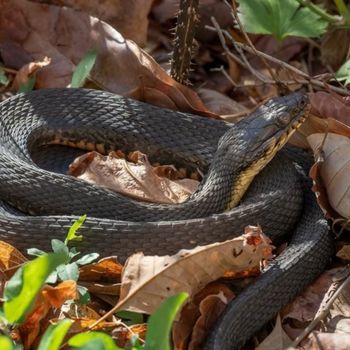 |
| 23 | Plains Black-headed Snake (Tantilla nigriceps) |
| 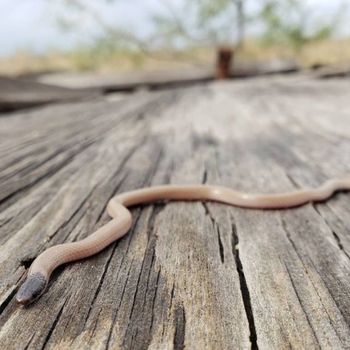 |
| 24 | Plains Garter Snake (Thamnophis radix) |
| 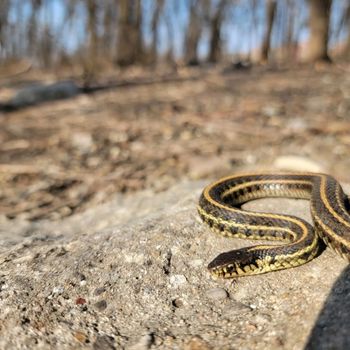 |
| 25 | Plains Hog-nosed Snake (Heterodon nasicus) |
| 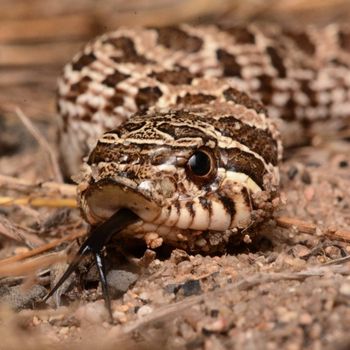 |
| 26 | Prairie Kingsnake (Lampropeltis calligaster) |
|  |
| 27 | Prairie Rattlesnake (Crotalus viridis) |
| 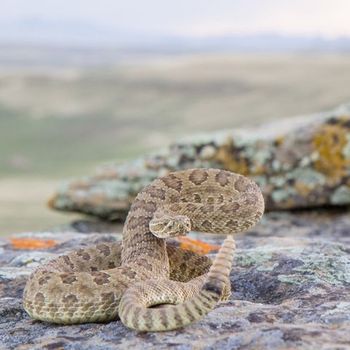 |
| 28 | Red-Bellied Snake (Storeria occipitomaculata) |
|  |
| 29 | Ringneck Snake (Diadophis punctatus) |
|  |
| 30 | Rough Earth Snake (Virginia striatula) |
|  |
| 31 | Rough Green Snake (Opheodrys aestivus) |
| 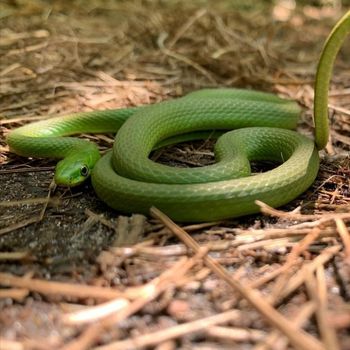 |
| 32 | Smooth Earth Snake (Virginia valeriae) |
| 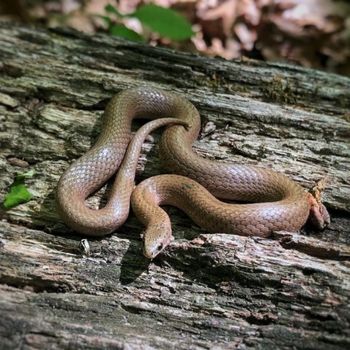 |
| 33 | Smooth Green Snake (Opheodrys vernalis) |
| 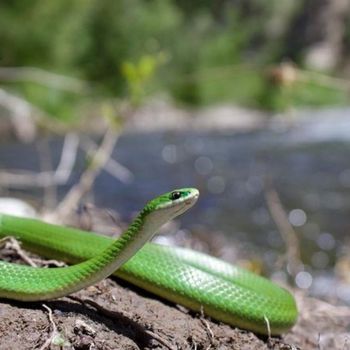 |
| 34 | Speckled Kingsnake (Lampropeltis holbrooki) |
| 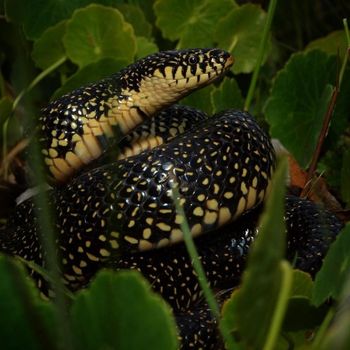 |
| 35 | Timber Rattlesnake (Crotalus horridus) |
|  |
| 36 | Western Earth Snake (Virginia valeriae) |
| 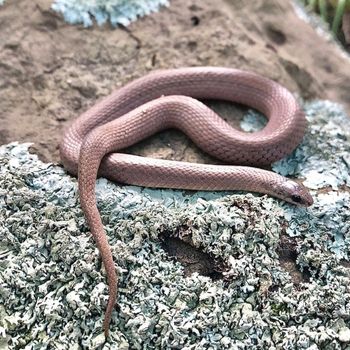 |
| 37 | Western Massasauga (Sistrurus tergeminus) |
| 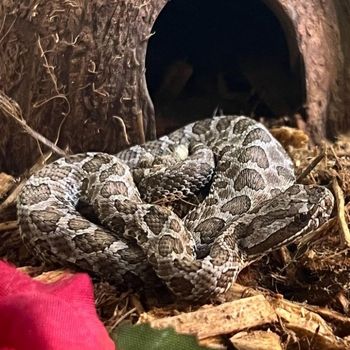 |
| 38 | Western Rat Snake (Pantherophis obsoletus) |
| 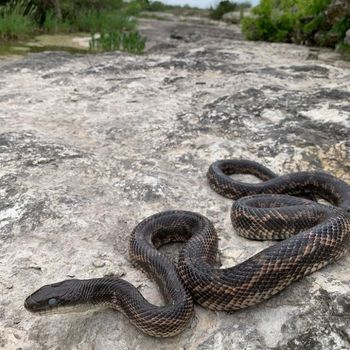 |
| 39 | Western Ribbonsnake (Thamnophis proximus) |
| 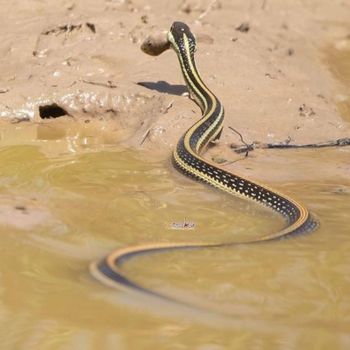 |
| 40 | Western Wormsnake (Carphophis vermis) |
| 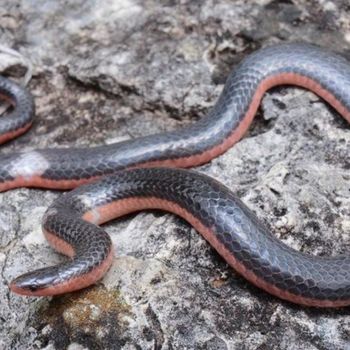 |
40 Snakes You Can Find in Kansas
In the state of Kansas, a fascinating array of serpents can be found slithering through its diverse landscapes. From venomous to harmless, each species has its unique story to tell. Below, we’ll explore the wonders of these often misunderstood creatures of Kansas, from their natural habitats and behaviors to the challenges they face in our changing world. In Kansas, you can find snakes such as the prairie rattlesnake, milk snake, western ribbonsnake, and many others. These snakes play essential roles in their ecosystems, helping to maintain balance and control populations of other species. Similarly, snakes in New Mexico also contribute to their local ecosystems in important ways, and understanding and respecting these creatures is vital for their conservation and the health of their habitats.
1. Broad-banded Copperhead
- Scientific Name: Agkistrodon contortrix laticinctus
- Common Name: Broad-banded copperhead
- Size: 20-36 inches (51-91 cm)
- Natural Habitat: Forests, grasslands, and rocky terrains
- Color: Coppery-brown with dark bands
- Habitat: Forests, grasslands, and rocky terrains
- Maximum Size: 20-36 inches (51-91 cm)
- Diet: Rodents, birds, and amphibians
- Reproduction: Viviparous, 3-10 offspring per litter
- Venom: Venomous (hemotoxic)
- Conservation: Least concern
The Broad-banded Copperhead (Agkistrodon contortrix laticinctus) is a venomous snake, measuring 20-36 inches (51-91 cm) in length. It exhibits a coppery-brown color with dark bands, and inhabits forests, grasslands, and rocky terrains. As a nocturnal and terrestrial species, its diet primarily consists of rodents, birds, and amphibians. The snake is viviparous, giving birth to 3-10 offspring per litter. Its venom is hemotoxic, and despite its potential danger to humans, it has a conservation status of Least Concern.
2. Checkered Garter Snake
- Scientific Name: Thamnophis marcianus
- Common Name: Checkered garter snake
- Size: 18-42 inches (46-106 cm)
- Natural Habitat: Near water sources, grasslands, and woodlands
- Color: Olive, brown, or black with checkered pattern
- Habitat: Near water sources, grasslands, and woodlands
- Maximum Size: 18-42 inches (46-106 cm)
- Diet: Earthworms, amphibians, and small fish
- Reproduction: Live-bearing, 5-40 offspring per litter
- Venom: Mildly venomous, not harmful to humans
- Conservation: Least concern
Introducing the Checkered Garter Snake (Thamnophis marcianus), a stunning serpent dressed in olive, brown, or black with an eye-catching checkered pattern. This slithering beauty, measuring 18-42 inches (46-106 cm), loves to hang out near water sources, grasslands, and woodlands. As a diurnal and semi-aquatic creature, it feasts on earthworms, amphibians, and small fish. Fear not, as their mildly venomous bite is harmless to humans. These live-bearing reptiles can produce 5-40 offspring per litter. Currently, their conservation status is of least concern.
3. Chihuahuan Nightsnake
- Scientific Name: Hypsiglena jani
- Common Name: Chihuahuan nightsnake
- Size: Up to 2 feet (61 cm)
- Natural Habitat: Desert scrub, grasslands, and rocky outcrops
- Color: Tan or light brown with dark blotches
- Habitat: Desert scrub, grasslands, and rocky outcrops
- Maximum Size: Up to 2 feet (61 cm)
- Diet: Small lizards, snakes and amphibians
- Reproduction: Lay eggs in small clutches of about 2-4
- Venom: Mildly venomous, but not harmful to humans
- Conservation: Least concern
The Chihuahuan Nightsnake, scientifically known as Hypsiglena jani, is a nocturnal and terrestrial snake of Kansas that measures up to 2 feet (61 cm). It sports a tan or light brown color with dark blotches, and inhabits desert scrub, grasslands, and rocky outcrops. Its diet consists of small lizards, snakes, and amphibians. These mildly venomous snakes reproduce by laying eggs in small clutches of about 2-4. While not harmful to humans, their conservation status is currently listed as “Least Concern.”
4. Coachwhip Snake
- Scientific Name: Masticophis flagellum
- Common Name: Coachwhip snake
- Size: Up to 8 feet (2.4 meters)
- Natural Habitat: Deserts, grasslands, and woodlands
- Color: Variety of colors, including tan, brown, pink, and black
- Habitat: Deserts, grasslands, and woodlands
- Maximum Size: Up to 8 feet (2.4 meters)
- Diet: Lizards, small mammals, birds
- Reproduction: Lay eggs in clutches of 3-15
- Venom: Non-venomous
- Conservation: Least concern
The Coachwhip Snake, scientifically known as Masticophis flagellum, is a swift, diurnal serpent native to deserts, grasslands, and woodlands. Growing up to 8 feet (2.4 meters) long, this non-venomous snake displays a variety of colors, from tan, brown, pink, to black. As adept hunters, Coachwhip Snakes primarily feed on lizards, small mammals, and birds. Mating leads to egg clutches ranging from 3-15. Despite their striking appearance, their conservation status remains classified as least concern.
5. Common Garter Snake
- Scientific Name: Thamnophis sirtalis
- Common Name: Common garter snake
- Size: Up to 3-4 feet (0.9-1.2 meters)
- Natural Habitat: Wet and moist habitats, including marshes, fields, and forests
- Color: Green or brown with three yellow stripes
- Habitat: Wet and moist habitats, including marshes, fields, and forests
- Maximum Size: Up to 3-4 feet (0.9-1.2 meters)
- Diet: Frogs, fish, earthworms, and small mammals
- Reproduction: Gives birth to live young, 10-40 per litter
- Venom: Mildly venomous, harmless to humans
- Conservation: Least concern
The Common Garter Snake (Thamnophis sirtalis) is a 3-4 feet (0.9-1.2 meters) non-aggressive and mildly venomous reptile with a green or brown body and three yellow stripes. Inhabiting wet and moist habitats like marshes, fields, and forests of Kansas, these diurnal snakes hibernate during winter to escape the cold. Their diet consists of frogs, fish, earthworms, and small mammals. Uniquely, these snakes birth live young, producing 10-40 per litter. Although venomous, they pose no threat to humans and are currently listed as a species of least concern for conservation.
6. Common Water Snake
- Scientific Name: Nerodia sipedon
- Common Name: Common water snake
- Size: Up to 4.5 feet (1.4 meters)
- Natural Habitat: Aquatic habitats, including lakes, rivers, and ponds
- Color: Brown or gray with dark bands or blotches
- Habitat: Aquatic habitats, including lakes, rivers, and ponds
- Maximum Size: Up to 4.5 feet (1.4 meters)
- Diet: Fish, frogs, and salamanders
- Reproduction: Give birth to live young in litters of 10-40
- Venom: Non-venomous, but can release a foul-smelling musk
- Conservation: Least concern
The Common Water Snake (Nerodia sipedon) is a non-venomous, nocturnal, semiaquatic reptile that can grow up to 4.5 feet (1.4 meters) in size. Their brown or gray body has dark bands or blotches as markings. Commonly found in aquatic habitats like lakes, rivers, and ponds, this snake’s diet consists of fish, frogs, and salamanders. It reproduces by giving birth to live young in litters containing 10-40 offspring. Although non-venomous, it can release foul-smelling musk in defense. Its conservation status is of least concern.
7. Cottonmouth
- Scientific Name: Agkistrodon piscivorus
- Common Name: Cottonmouth, water moccasin
- Size: 30-48 inches (76-122 cm)
- Natural Habitat: Swamps, marshes, rivers, and ponds
- Color: Olive, brown, or black with dark bands
- Habitat: Swamps, marshes, rivers, and ponds
- Maximum Size: 30-48 inches (76-122 cm)
- Diet: Fish, amphibians, rodents, birds, and other reptiles
- Reproduction: Give birth to live young (ovoviviparous), 1-16 offspring
- Venom: Venomous, hemotoxic venom
- Conservation: Least concern
The Cottonmouth (Agkistrodon piscivorus), also known as Water Moccasin, is a venomous snake measuring 30-48 inches (76-122 cm) in length. It features an olive, brown, or black coloration with dark bands. These semi-aquatic, nocturnal reptiles inhabit swamps, marshes, rivers, and ponds. Notably aggressive when threatened, their diet consists of fish, amphibians, rodents, birds, and other reptiles. Cottonmouths give birth to live young (ovoviviparous), producing 1-16 offspring. Their venom is hemotoxic, but their conservation status remains of least concern.
8. Dekay’s Brownsnake
- Scientific Name: Storeria dekayi
- Common Name: Dekay’s brown snake
- Size: 9-15 inches (23-38 cm)
- Natural Habitat: Forests, grasslands, wetlands, and urban areas
- Color: Brown or gray with dark spots
- Habitat: Forests, grasslands, wetlands, and urban areas
- Maximum Size: 9-15 inches (23-38 cm)
- Diet: Earthworms, slugs, and other soft-bodied invertebrates
- Reproduction: Give birth to live young (ovoviviparous), 3-40 offspring
- Venom: Non-venomous
- Conservation: Least concern
Storeria dekayi, commonly known as Dekay’s Brown Snake, is a small, non-venomous reptile, measuring 9-15 inches (23-38 cm) in length. Its brown or gray body features dark spots, and it inhabits forests, grasslands, wetlands, and urban areas. Exhibiting terrestrial, nocturnal, and secretive behavior, its diet consists primarily of earthworms, slugs, and other soft-bodied invertebrates. A fascinating ovoviviparous species, Dekayís Brown Snake gives birth to live young, bearing 3-40 offspring. Its current conservation status is classified as least concern.
9. Diamond-backed Water Snake
- Scientific Name: Nerodia rhombifer
- Common Name: Diamond-backed water snake
- Size: 30-48 inches (76-122 cm)
- Natural Habitat: Freshwater habitats, lakes, rivers, and swamps
- Color: Olive-green or brown with dark diamond patterns
- Habitat: Freshwater habitats, lakes, rivers, and swamps
- Maximum Size: 30-48 inches (76-122 cm)
- Diet: Fish, amphibians, and small reptiles
- Reproduction: Live birth, 13-60 young per litter
- Venom: Non-venomous
- Conservation: Least concern
The Diamond-backed Water Snake (Nerodia rhombifer) is a non-venomous reptile measuring 30-48 inches (76-122 cm) in length. Its olive-green or brown skin features dark diamond patterns, providing excellent camouflage in its freshwater habitat which includes lakes, rivers, and swamps. As a diurnal and nocturnal creature, this adept swimmer mainly feeds on fish, amphibians, and small reptiles. The species reproduces through live birth, with each litter consisting of 13-60 young. Currently, it holds a conservation status of Least Concern.
10. Eastern Copperhead
- Scientific Name: Agkistrodon contortrix
- Common Name: Eastern copperhead
- Size: Up to 3 feet (90 centimeters)
- Natural Habitat: Forests, swamps, and river bottoms
- Color: Reddish-brown with hourglass-shaped bands
- Habitat: Forests, swamps, and river bottoms
- Maximum Size: Up to 3 feet (90 centimeters)
- Diet: Small rodents, birds, frogs, and insects
- Reproduction: Live-bearing, 2-18 young per litter
- Venom: Venomous, hemotoxic venom
- Conservation: Least concern
The Eastern Copperhead (Agkistrodon contortrix) is a venomous snake that can grow up to 3 feet (90cm) in length. Its distinctive reddish-brown body features hourglass-shaped bands and prefers habitats such as forests, swamps, and river bottoms of Kansas. These nocturnal, terrestrial creatures primarily feed on small rodents, birds, frogs, and insects. Eastern Copperheads are live-bearing, with litters ranging from 2-18 young. Their hemotoxic venom can be dangerous, but their conservation status is considered least concern.
11. Eastern Hog-nosed Snake
- Scientific Name: Heterodon platirhinos
- Common Name: Eastern hog-nosed snake
- Size: 20-33 inches (51-84 cm)
- Natural Habitat: Woodlands, grasslands, and sandy areas
- Color: Highly variable, typically brown or gray with dark blotches
- Habitat: Woodlands, grasslands, and sandy areas
- Maximum Size: 20-33 inches (51-84 cm)
- Diet: Mostly toads, but also other amphibians and small mammals
- Reproduction: Lay eggs, 4-60 per clutch
- Venom: Mild venom, harmless to humans
- Conservation: Least concern
The Eastern Hog-nosed Snake (Heterodon platirhinos) is a moderately-sized serpent, reaching lengths of 20-33 inches (51-84 cm). Its coloration is highly variable, typically exhibiting brown or gray hues with dark blotches. Inhabiting woodlands, grasslands, and sandy areas, this diurnal snake is known for playing dead when threatened. Its diet mainly consists of toads, along with other amphibians and small mammals. It reproduces by laying 4-60 eggs per clutch, has mild venom harmless to humans, and is classified as of “Least Concern” in conservation efforts.
12. Eastern Milksnake
- Scientific Name: Lampropeltis triangulum
- Common Name: Eastern milksnake
- Size: Up to 3.9 feet (1.2 meters)
- Natural Habitat: Forests, grasslands, farmlands, and rocky areas
- Color: Reddish-brown with y-shaped black-edged white bands
- Habitat: Forests, grasslands, farmlands, and rocky areas
- Maximum Size: Up to 3.9 feet (1.2 meters)
- Diet: Rodents, small birds, and reptiles
- Reproduction: Lay eggs in clutches of 3-20
- Venom: Non-venomous
- Conservation: Least concern
The Eastern Milksnake (Lampropeltis triangulum) is a non-venomous snake that grows up to 3.9 feet (1.2 meters) in length. It features a reddish-brown color adorned with Y-shaped black-edged white bands. Commonly found in forests, grasslands, farmlands, and rocky areas of Kansas, this nocturnal and terrestrial snake primarily consumes rodents, small birds, and reptiles. Eastern Milksnakes reproduce by laying egg clutches of 3-20. Currently, their conservation status is listed as least concern.
13. Flat-headed Snake
- Scientific Name: Tantilla gracilis
- Common Name: Flathead snake
- Size: 7-12 inches (18-30 cm)
- Natural Habitat: Grasslands, woodlands, and rocky areas
- Color: Brown or reddish-brown with black head and yellow neck band
- Habitat: Grasslands, woodlands, and rocky areas
- Maximum Size: 7-12 inches (18-30 cm)
- Diet: Centipedes and other small invertebrates
- Reproduction: Lay eggs, 1-3 per clutch
- Venom: Non-venomous
- Conservation: Least concern
The Flat-headed Snake (Tantilla gracilis) is a small, non-venomous reptile measuring 7-12 inches in length. It sports a brown or reddish-brown body with a distinct black head and a yellow neck band. Native to grasslands, woodlands, and rocky areas, this nocturnal and secretive snake primarily feeds on centipedes and other small invertebrates. Flat-headed snakes reproduce by laying eggs, with each clutch consisting of 1-3 eggs. Currently, their conservation status is classified as least concern.
14. Glossy Snake
- Scientific Name: Arizona elegans
- Common Name: Glossy snake
- Size: Up to 5 feet (1.5 meters)
- Natural Habitat: Desert, grassland, and scrub habitats
- Color: Gray or brown with dark blotches
- Habitat: Desert, grassland, and scrub habitats
- Maximum Size: Up to 5 feet (1.5 meters)
- Diet: Small mammals, lizards, and snakes
- Reproduction: Lay eggs in clutches of 3-12
- Venom: Non-venomous
- Conservation: Least concern
The Glossy Snake (Arizona elegans) is a non-venomous, nocturnal reptile found in desert, grassland, and scrub habitats across North America. Measuring up to 5 feet (1.5 meters) in length, this resident of Kansas boasts a gray or brown coloration with dark blotches. As a terrestrial creature, the Glossy Snake feeds on small mammals, lizards, and other snakes, and reproduces by laying egg clutches of 3 to 12. With a conservation status of ‘least concern’, it continues to thrive in its native regions.
15. Gophersnake
- Scientific Name: Pituophis catenifer
- Common Name: Gophersnake
- Size: Up to 7 feet (2.1 meters)
- Natural Habitat: Deserts, grasslands, forests, and agricultural areas
- Color: Yellow, brown, or cream with dark spots
- Habitat: Deserts, grasslands, forests, and agricultural areas
- Maximum Size: Up to 7 feet (2.1 meters)
- Diet: Mammals, birds, eggs, and reptiles
- Reproduction: Lay eggs in clutches of 2-24
- Venom: Non-venomous
- Conservation: Least concern
The Gophersnake (Pituophis catenifer) is a non-venomous snake species measuring up to 7 feet (2.1 meters) in length. They exhibit yellow, brown, or cream-colored scales with dark spots. Gophersnakes thrive in various habitats such as deserts, grasslands, forests, and agricultural areas. These diurnal, burrow-dwelling reptiles primarily feed on mammals, birds, eggs, and other reptiles. Gophersnakes reproduce through laying egg clutches, consisting of 2-24 eggs. Currently, they have a conservation status of least concern.
16. Graham’s Crayfish Snake
- Scientific Name: Regina grahamii
- Common Name: Graham’s crayfish snake
- Size: 18-42 inches (46-107 cm)
- Natural Habitat: Wetlands, lakes, ponds, and slow-moving streams
- Color: Brown or olive-brown with dark spots
- Habitat: Wetlands, lakes, ponds, and slow-moving streams
- Maximum Size: 18-42 inches (46-107 cm)
- Diet: Primarily crayfish, also small fish and amphibians
- Reproduction: Lay eggs in clutches of 5-25
- Venom: Non-venomous
- Conservation: Least concern
Regina grahamii, commonly known as Graham’s Crayfish Snake, is a non-venomous aquatic species that measures between 18-42 inches in length. Its brown or olive-brown coloration is marked with dark spots. This nocturnal and secretive snake inhabits wetlands, lakes, ponds, and slow-moving streams. Its primary diet consists of crayfish, supplemented by small fish and amphibians. The snake lays eggs in clutches of 5-25, and its conservation status is currently classified as “least concern.”
17. Great Plains Rat Snake
- Scientific Name: Pantherophis emoryi
- Common Name: Great plains rat snake
- Size: Up to 5 feet (1.5 meters)
- Natural Habitat: Grasslands, prairies, and open woodlands
- Color: Gray or brown with dark blotches
- Habitat: Grasslands, prairies, and open woodlands
- Maximum Size: Up to 5 feet (1.5 meters)
- Diet: Rodents, birds, and eggs
- Reproduction: Lay eggs in clutches of 5-20
- Venom: Non-venomous
- Conservation: Least concern
The Great Plains Rat Snake (Pantherophis emoryi) is a non-venomous snake species that can reach up to 5 feet (1.5 meters) in length. They exhibit gray or brown coloring with dark blotches and inhabit grasslands, prairies, and open woodlands of Kansas. These snakes are primarily nocturnal and terrestrial, preying on rodents, birds, and eggs to maintain a healthy diet. Females lay eggs in clutches of 5-20, contributing to their conservation status of “least concern.”
18. Lined Snake
- Scientific Name: Tropidoclonion lineatum
- Common Name: Lined snake
- Size: Up to 20 inches (51 cm)
- Natural Habitat: Grasslands, prairies, and urban areas
- Color: Gray or tan with dark stripes
- Habitat: Grasslands, prairies, and urban areas
- Maximum Size: Up to 20 inches (51 cm)
- Diet: Earthworms, slugs, and soft-bodied insects
- Reproduction: Lay eggs in clutches of 2-12
- Venom: Non-venomous
- Conservation: Least concern
The Lined Snake (Tropidoclonion lineatum) is a small, non-venomous species, growing up to 20 inches (51 cm). It has a gray or tan colored body with dark stripes, adapted to living in grasslands, prairies, and urban areas. Being nocturnal and fossorial, this reptile primarily feeds on earthworms, slugs, and soft-bodied insects. Lined Snakes reproduce by laying eggs in clutches of 2-12. With a conservation status of least concern, they remain a thriving species.
19. Long-Nosed Snake
- Scientific Name: Rhinocheilus lecontei
- Common Name: Long-nosed snake
- Size: Up to 30 – 52 inches (76 – 132 cm)
- Natural Habitat: Semi-arid or desert areas, grasslands, scrublands, and rocky terrain
- Color: Black or brown with red, cream, or white bands
- Habitat: Semi-arid or desert areas, grasslands, scrublands, and rocky terrain
- Maximum Size: Up to 30 – 52 inches (76 – 132 cm)
- Diet: Rodents, lizards, and small mammals
- Reproduction: Lay eggs in clutches of 3-10
- Venom: Non-venomous
- Conservation: Least concern
The Long-Nosed Snake (Rhinocheilus lecontei) is a non-venomous reptile that reaches lengths of 30-52 inches (76-132 cm). Its distinct black or brown coloration features red, cream, or white bands. Commonly found in semi-arid or desert areas, grasslands, scrublands, and rocky terrain, this nocturnal creature is terrestrial, non-aggressive, and primarily feeds on rodents, lizards, and small mammals. Long-nosed snakes reproduce by laying clutches of 3-10 eggs, and their conservation status is listed as least concern.
20. New Mexico Threadsnake
- Scientific Name: Leptotyphlops dissectus
- Common Name: New mexico threadsnake
- Size: Up to 7.5 inches (19 centimeters)
- Natural Habitat: Desert, grasslands, and rocky areas
- Color: Light pink or brown
- Habitat: Desert, grasslands, and rocky areas
- Maximum Size: Up to 7.5 inches (19 centimeters)
- Diet: Ants and termites
- Reproduction: Lay eggs in clutches of 1-2
- Venom: Non-venomous
- Conservation: Least concern
The New Mexico Threadsnake (Leptotyphlops dissectus) is a small, non-venomous snake reaching up to 7.5 inches (19 cm) in length, with a light pink or brown color. Found in desert, grassland, and rocky habitats of New Mexico, these nocturnal, fossorial reptiles spend most of their time burrowing underground. Their diet primarily consists of ants and termites. Reproduction involves laying small clutches of 1-2 eggs. Currently, the New Mexico Threadsnake’s conservation status is listed as least concern.
21. North American Racer
- Scientific Name: Coluber constrictor
- Common Name: North american racer
- Size: Up to 6 feet (1.8 meters)
- Natural Habitat: Grasslands, meadows, forests, and farmlands
- Color: Blue, gray, or greenish with a white or yellow underside
- Habitat: Grasslands, meadows, forests, and farmlands
- Maximum Size: Up to 6 feet (1.8 meters)
- Diet: Small mammals, birds, frogs, and insects
- Reproduction: Lay eggs in clutches of 4-30
- Venom: Non-venomous
- Conservation: Least concern
The North American Racer (Coluber constrictor) is a non-venomous snake species that can reach up to 6 feet (1.8 meters) in length. Characterized by blue, gray, or greenish scales and a white or yellow underside, these diurnal and terrestrial creatures inhabit grasslands, meadows, forests, and farmlands. Known for their fast-moving behavior, they primarily feed on small mammals, birds, frogs, and insects. North American Racers reproduce by laying eggs in clutches of 4-30, and their conservation status is listed as least concern.
22. Plain-bellied Watersnake
- Scientific Name: Nerodia erythrogaster
- Common Name: Plain-bellied watersnake
- Size: 24-40 inches (61-102 cm)
- Natural Habitat: Rivers, lakes, ponds, and wetlands
- Color: Olive, brown, or gray with a yellow, orange, or red unmarked belly
- Habitat: Rivers, lakes, ponds, and wetlands
- Maximum Size: 24-40 inches (61-102 cm)
- Diet: Fish, frogs, and other amphibians
- Reproduction: Live-bearing; 5-29 offspring per litter
- Venom: Non-venomous
- Conservation: Least concern
The Plain-bellied Watersnake (Nerodia erythrogaster) is a semi-aquatic, non-venomous snake measuring 24-40 inches (61-102 cm) in length. It features an olive, brown, or gray coloration with a distinct yellow, orange, or red unmarked belly. As adept swimmers, they inhabit rivers, lakes, ponds, and wetlands, with diurnal behavior. Their diet primarily consists of fish, frogs, and other amphibians. These snakes are live-bearing, producing 5-29 offspring per litter. Currently, their conservation status is of least concern.
23. Plains Black-headed Snake
- Scientific Name: Tantilla nigriceps
- Common Name: Plains black-headed snake
- Size: 7-15 inches (18-38 cm)
- Natural Habitat: Desert scrub, grasslands, and woodlands
- Color: Gray or light brown with a black head
- Habitat: Desert scrub, grasslands, and woodlands
- Maximum Size: 7-15 inches (18-38 cm)
- Diet: Insects, centipedes, and spiders
- Reproduction: Lay eggs in small clutches
- Venom: Non-venomous
- Conservation: Least concern
The Plains Black-headed Snake (Tantilla nigriceps) is a small, non-venomous reptile, measuring 7-15 inches (18-38 cm) in length. It is characterized by its gray or light brown coloration and distinctive black head. This nocturnal and burrowing snake inhabits desert scrub, grasslands, and woodlands, where it primarily feeds on insects, centipedes, and spiders. Reproduction involves laying eggs in small clutches. Despite its unique appearance, it is currently classified as a species of least concern in terms of conservation.
24. Plains Garter Snake
- Scientific Name: Thamnophis radix
- Common Name: Plains garter snake
- Size: 16-28 inches (41-71 cm)
- Natural Habitat: Grasslands, wetlands, and areas near water sources
- Color: Brown or gray with yellow or orange stripes
- Habitat: Grasslands, wetlands, and areas near water sources
- Maximum Size: 16-28 inches (41-71 cm)
- Diet: Earthworms, amphibians, fish, and invertebrates
- Reproduction: Live-bearing; 6-80 offspring per litter
- Venom: Non-venomous
- Conservation: Least concern
The Plains Garter Snake (Thamnophis radix) is a non-venomous reptile characterized by its brown or gray color with yellow or orange stripes. Typically measuring 16-28 inches (41-71 cm) in length, it thrives in grasslands, wetlands, and areas near water sources. These diurnal, semi-aquatic snakes are known for their swimming prowess. They feed primarily on earthworms, amphibians, fish, and invertebrates. Mating results in live births, producing 6-80 offspring per litter. Currently, their conservation status is of least concern.
25. Plains Hog-nosed Snake
- Scientific Name: Heterodon nasicus
- Common Name: Plains hog-nosed snake
- Size: Up to 25 inches (63.5 cm)
- Natural Habitat: Grasslands, sandy or gravelly areas, floodplains
- Color: Reddish-brown, tan, or gray with dark blotches
- Habitat: Grasslands, sandy or gravelly areas, floodplains
- Maximum Size: Up to 25 inches (63.5 cm)
- Diet: Toads, lizards, small mammals, and reptile eggs
- Reproduction: Lay eggs in clutches of 4-19
- Venom: Mildly venomous, not dangerous to humans
- Conservation: Least concern
The Plains Hog-nosed Snake (Heterodon nasicus) is a mildly venomous reptile, characterized by its reddish-brown, tan, or gray color with dark blotches. Found in grasslands, sandy or gravelly areas, and floodplains, this snake is a diurnal burrower that plays dead when threatened. Measuring up to 25 inches (63.5 cm) in length, this snake primarily feeds on toads, lizards, small mammals, and reptile eggs. Females lay eggs in clutches of 4-19. Although mildly venomous, Plains Hog-nosed Snakes pose no threat to humans, and their conservation status is listed as least concern.
26. Prairie Kingsnake
- Scientific Name: Lampropeltis calligaster
- Common Name: Prairie kingsnake
- Size: 30-42 inches (76-107 cm)
- Natural Habitat: Grasslands, farmlands, and woodlands
- Color: Gray or light brown with dark blotches
- Habitat: Grasslands, farmlands, and woodlands
- Maximum Size: 30-42 inches (76-107 cm)
- Diet: Rodents, birds, lizards, and amphibians
- Reproduction: Lay eggs in clutches of 5-17
- Venom: Non-venomous
- Conservation: Least concern
The Prairie Kingsnake (Lampropeltis calligaster) is a non-venomous reptile that measures 30-42 inches (76-107cm) in length. It has a gray or light brown color, adorned with dark blotches. Commonly found in grasslands, farmlands, and woodlands, Prairie Kingsnakes are terrestrial and nocturnal by nature. Their diet includes rodents, birds, lizards, and amphibians. During reproduction, they lay clutches containing 5-17 eggs. Currently, the Prairie Kingsnake’s conservation status is listed as least concern.
27. Prairie Rattlesnake
- Scientific Name: Crotalus viridis
- Common Name: Prairie rattlesnake
- Size: 20-50 inches (51-127 cm)
- Natural Habitat: Prairies, grasslands, and scrublands
- Color: Greenish or brownish with dark bands and a rattle on the tail
- Habitat: Prairies, grasslands, and scrublands
- Maximum Size: 20-50 inches (51-127 cm)
- Diet: Small mammals, birds, and reptiles
- Reproduction: Live-bearing; 4-21 offspring per litter
- Venom: Venomous, potentially dangerous to humans but usually not fatal
- Conservation: Least concern
The Prairie Rattlesnake (Crotalus viridis) is a venomous snake inhabiting prairies, grasslands, and scrublands. Typically measuring 20-50 inches (51-127 cm) in length, it features a greenish or brownish coloration with dark bands and a distinctive rattle on its tail. As nocturnal, terrestrial, and ambush predators, they mainly feed on small mammals, birds, and reptiles. These live-bearing snakes, with 4-21 offspring per litter, pose a potential danger to humans though their venom is usually not fatal. Currently, they hold a conservation status of Least Concern.
28. Red-Bellied Snake
- Scientific Name: Storeria occipitomaculata
- Common Name: Red-bellied snake
- Size: 8-16 inches (20-41 cm)
- Natural Habitat: Forests, woodlands, and wetlands
- Color: Gray or brown with a red or orange belly
- Habitat: Forests, woodlands, and wetlands
- Maximum Size: 8-16 inches (20-41 cm)
- Diet: Slugs, snails, and earthworms
- Reproduction: Live-bearing; 4-21 offspring per litter
- Venom: Non-venomous
- Conservation: Least concern
The Red-Bellied Snake (Storeria occipitomaculata) is a small, non-venomous snake measuring 8-16 inches (20-41 cm) in length. They are gray or brown with a distinctive red or orange belly. Mostly found in forests, woodlands, and wetlands of Kansas, these nocturnal and secretive creatures primarily feed on slugs, snails, and earthworms. As live-bearing reptiles, they produce 4-21 offspring in each litter. With a conservation status of “Least Concern,” this terrestrial snake presents no significant threat to humans.
29. Ringneck Snake
- Scientific Name: Diadophis punctatus
- Common Name: Ringneck snake
- Size: 12-15 inches (30-38 centimeters)
- Natural Habitat: Forests, grasslands, and urban areas
- Color: Gray or dark brown with yellow or orange ring around the neck
- Habitat: Forests, grasslands, and urban areas
- Maximum Size: 12-15 inches (30-38 centimeters)
- Diet: Small invertebrates such as insects, worms, and slugs
- Reproduction: Lay eggs in clutches of 3-10
- Venom: Mildly venomous, but not harmful to humans
- Conservation: Least concern
The Ringneck Snake (Diadophis punctatus) is a small, mildly venomous serpent, measuring 12-15 inches (30-38 centimeters) in length. Exhibiting a gray or dark brown coloration with a distinct yellow or orange ring around its neck, this species prefers habitats including forests, grasslands, and urban areas. As nocturnal, secretive creatures, Ringneck Snakes are found hiding under rocks or logs, feeding on small invertebrates such as insects, worms, and slugs. Reproducing by laying 3-10 eggs per clutch, this snake is presently classified as least concern in terms of conservation status.
30. Rough Earth Snake
- Scientific Name: Virginia striatula
- Common Name: Rough earth snake
- Size: Up to 10-14 inches (25-35 cm)
- Natural Habitat: Wooded or grassy areas, often near water sources
- Color: Brown or gray with smooth scales
- Habitat: Wooded or grassy areas, often near water sources
- Maximum Size: Up to 10-14 inches (25-35 cm)
- Diet: Earthworms and other small invertebrates
- Reproduction: Lay eggs in clutches of 3-8
- Venom: Non-venomous
- Conservation: Least concern
The Rough Earth Snake (Virginia striatula) is a small, non-venomous snake that grows up to 10-14 inches (25-35 cm) in length. Sporting a brown or gray color and smooth scales, they typically inhabit wooded or grassy areas, often near water sources. As secretive and burrow-dwelling creatures, their diet primarily consists of earthworms and other small invertebrates. They reproduce by laying clutches of 3-8 eggs, and their conservation status currently stands at “Least Concern.”
31. Rough Green Snake
- Scientific Name: Opheodrys aestivus
- Common Name: Rough green snake
- Size: 22-32 inches (56-81 cm)
- Natural Habitat: Forests, grasslands, and areas near water sources
- Color: Bright green with a lighter belly
- Habitat: Forests, grasslands, and areas near water sources
- Maximum Size: 22-32 inches (56-81 cm)
- Diet: Insects and spiders
- Reproduction: Lay eggs in clutches of 3-12
- Venom: Non-venomous
- Conservation: Least concern
The Rough Green Snake (Opheodrys aestivus) is a vibrant, non-venomous reptile that measures between 22-32 inches (56-81 cm) in length. Its dazzling bright green coloration is accentuated by a lighter belly, making it well-camouflaged in its preferred habitats of forests, grasslands, and areas near water sources. Known for their diurnal, arboreal behavior, these skillful climbers of Kansas primarily consume insects and spiders. Rough Green Snakes reproduce by laying clutches of 3-12 eggs, and their conservation status is currently classified as least concern.
32. Smooth Earth Snake
- Scientific Name: Virginia valeriae
- Common Name: Smooth earth snake
- Size: 7-10 inches (18-25 cm)
- Natural Habitat: Forests, woodlands, and grasslands
- Color: Brown or gray with a lighter belly
- Habitat: Forests, woodlands, and grasslands
- Maximum Size: 7-10 inches (18-25 cm)
- Diet: Earthworms, slugs, and insects
- Reproduction: Live-bearing; 3-10 offspring per litter
- Venom: Non-venomous
- Conservation: Least concern
The Smooth Earth Snake (Virginia valeriae) is a small, non-venomous reptile measuring 7-10 inches (18-25 cm) in length. It has a brown or gray coloration, with a lighter belly, and inhabits forests, woodlands, and grasslands. This secretive, nocturnal snake is known for burrow-dwelling and primarily feasts on earthworms, slugs, and insects. The species is live-bearing, producing 3-10 offspring per litter. With a conservation status of “Least Concern,” the Smooth Earth Snake population remains relatively stable.
33. Smooth Green Snake
- Scientific Name: Opheodrys vernalis
- Common Name: Smooth green snake
- Size: 14-20 inches (36-51 cm)
- Natural Habitat: Grasslands, meadows, and open woodlands
- Color: Bright green with a lighter belly
- Habitat: Grasslands, meadows, and open woodlands
- Maximum Size: 14-20 inches (36-51 cm)
- Diet: Insects and spiders
- Reproduction: Lay eggs in clutches of 3-12
- Venom: Non-venomous
- Conservation: Least concern
The Smooth Green Snake (Opheodrys vernalis) measures 14-20 inches (36-51 cm) and is characterized by its vibrant green color and lighter belly. Commonly found in grasslands, meadows, and open woodlands, this diurnal and terrestrial reptile is an adept climber. Its diet mainly consists of insects and spiders. In terms of reproduction, they lay eggs in clutches of 3-12. Though non-venomous, these snakes should be admired from afar. Fortunately, their conservation status is currently listed as ‘Least Concern.’
34. Speckled Kingsnake
- Scientific Name: Lampropeltis holbrooki
- Common Name: Speckled kingsnake
- Size: Up to 4 feet (1.2 meters)
- Natural Habitat: Forests, grasslands, and scrublands
- Color: Tan or light brown with dark brown or black speckles
- Habitat: Forests, grasslands, and scrublands
- Maximum Size: Up to 4 feet (1.2 meters)
- Diet: Small mammals, birds, and reptiles
- Reproduction: Lay eggs in clutches of 4-12
- Venom: Non-venomous
- Conservation: Least concern
The Speckled Kingsnake (Lampropeltis holbrooki) is a non-venomous reptile that grows up to 4 feet in length. Sporting a tan or light brown color with dark brown or black speckles, this snake dwells in forests, grasslands, and scrublands. As a diurnal and terrestrial creature, it preys on small mammals, birds, and reptiles during the day. Speckled Kingsnakes reproduce by laying eggs in clutches of 4-12, and are currently categorized as least concern in terms of conservation status.
35. Timber Rattlesnake
- Scientific Name: Crotalus horridus
- Common Name: Timber rattlesnake
- Size: Up to 6 feet (1.8 meters)
- Natural Habitat: Forests, mixed woodlands, and rocky hillsides
- Color: Yellow, brown, gray, or black with dark bands
- Habitat: Forests, mixed woodlands, and rocky hillsides
- Maximum Size: Up to 6 feet (1.8 meters)
- Diet: Rodents, birds, and small mammals
- Reproduction: Viviparous, giving birth to 4-14 live young
- Venom: Hemotoxic venom
- Conservation: Least concern
The Timber Rattlesnake, scientifically known as Crotalus horridus, is a solitary, ambush predator that can grow up to 6 feet (1.8 meters) in length. It comes in various colors, including yellow, brown, gray, or black with dark bands, and inhabits forests, mixed woodlands, and rocky hillsides. Its diet consists of rodents, birds, and small mammals. Unlike most snakes, the Timber Rattlesnake is viviparous, giving birth to 4-14 live young. It possesses hemotoxic venom, and its conservation status is currently listed as least concern.
36. Western Earth Snake
- Scientific Name: Virginia valeriae
- Common Name: Western earth snake
- Size: Up to 14 inches (35.5 cm)
- Natural Habitat: Wooded areas, rocky hillsides, and garden beds
- Color: Gray, brown or reddish with smooth scales
- Habitat: Wooded areas, rocky hillsides, and garden beds
- Maximum Size: Up to 14 inches (35.5 cm)
- Diet: Invertebrates, such as slugs, snails, worms, and insects
- Reproduction: Lay eggs in clutches of 1-8
- Venom: Non-venomous
- Conservation: Least concern
The Western Earth Snake (Virginia valeriae) is a small, non-venomous reptile that grows up to 14 inches (35.5 cm) in length. Its smooth-scaled skin varies in color from gray, brown, or reddish, allowing it to blend into wooded areas, rocky hillsides, and garden beds. As a secretive, predominantly nocturnal species, this snake feeds on invertebrates such as slugs, snails, worms, and insects. It reproduces by laying clutches of 1-8 eggs and is currently listed under the conservation status of “least concern.”
37. Western Massasauga
- Scientific Name: Sistrurus tergeminus
- Common Name: Western massasauga
- Size: 20 to 30 inches (51 to 76 cm)
- Natural Habitat: Grasslands, prairies, and marshy areas
- Color: Gray or light brown with dark brown blotches
- Habitat: Grasslands, prairies, and marshy areas
- Maximum Size: 20 to 30 inches (51 to 76 cm)
- Diet: Small mammals, birds, and reptiles
- Reproduction: Give birth to live young, 5-12 offspring per litter
- Venom: Venomous, but not typically fatal to humans
- Conservation: Least concern
The Western Massasauga (Sistrurus tergeminus) is a small rattlesnake, measuring between 20 to 30 inches (51 to 76 cm) in length. Their coloration is gray or light brown, adorned with dark brown blotches. Native to grasslands, prairies, and marshy areas, these nocturnal and terrestrial creatures mainly feed on small mammals, birds, and reptiles. They give birth to live young, with 5-12 offspring per litter. Although venomous, their bites are not typically fatal to humans. Currently, their conservation status is listed as least concern.
38. Western Rat Snake
- Scientific Name: Pantherophis obsoletus
- Common Name: Western rat snake
- Size: Up to 6.5 feet (2 meters)
- Natural Habitat: Various habitats, including forests, grasslands, and urban areas
- Color: Gray or brown with dark blotches
- Habitat: Various habitats, including forests, grasslands, and urban areas
- Maximum Size: Up to 6.5 feet (2 meters)
- Diet: Rodents, birds, and eggs
- Reproduction: Lay eggs in clutches of 5-20
- Venom: Non-venomous
- Conservation: Least concern
The Western Rat Snake (Pantherophis obsoletus) is a non-venomous species found in various habitats, including forests, grasslands, and urban areas. Measuring up to 6.5 feet (2 meters) long, this diurnal, semi-arboreal reptile exhibits a gray or brown coloration with dark blotches. Its diet primarily consists of rodents, birds, and eggs, making it an essential part of natural rodent population control. Breeding occurs through egg-laying, with each clutch containing 5-20 eggs. Western Rat Snakes have a conservation status of “least concern.”
39. Western Ribbonsnake
- Scientific Name: Thamnophis proximus
- Common Name: Western ribbonsnake
- Size: 18-30 inches (46-76 cm)
- Natural Habitat: Semi-aquatic habitats, wetlands, marshes, and grasslands near water
- Color: Black or dark brown with three bright yellow or white stripes
- Habitat: Semi-aquatic habitats, wetlands, marshes, and grasslands near water
- Maximum Size: 18-30 inches (46-76 cm)
- Diet: Fish, frogs, and tadpoles
- Reproduction: Lay eggs in clutches of 3-26
- Venom: Non-venomous
- Conservation: Least concern
The Western Ribbonsnake (Thamnophis proximus) is a slender reptile measuring 18-30 inches (46-76 cm) in length, characterized by its black or dark brown coloration adorned with three bright yellow or white stripes. Commonly found in semi-aquatic habitats such as wetlands, marshes, and grasslands near water, this diurnal creature is a swift swimmer, preying primarily on fish, frogs, and tadpoles. The non-venomous species reproduces by laying egg clutches of 3-26, and has a conservation status of ‘Least Concern’.
40. Western Wormsnake
- Scientific Name: Carphophis vermis
- Common Name: Western wormsnake
- Size: Up to 14 inches (35.5 cm)
- Natural Habitat: Deciduous forests, grasslands, and suburban areas with moist soil
- Color: Brown to black on the back and pink or light brown on the belly
- Habitat: Deciduous forests, grasslands, and suburban areas with moist soil
- Maximum Size: Up to 14 inches (35.5 cm)
- Diet: Earthworms and other soft-bodied invertebrates
- Reproduction: Lay eggs in clutches of 1-8
- Venom: Non-venomous
- Conservation: Least concern
The Western Wormsnake (Carphophis vermis) is a non-venomous, small-sized reptile reaching up to 14 inches (35.5 cm) in length. It exhibits a distinct color pattern of brown-to-black on its back and pink or light brown on its belly. Inhabiting deciduous forests, grasslands, and moist suburban areas, this elusive, nocturnal creature primarily burrows underground and feeds on earthworms and soft-bodied invertebrates. Western Wormsnakes lay small egg clutches (1-8) and have a conservation status of Least Concern.
Nearby States:
Final Words
All the 40 snakes have truly opened our eyes to the fascinating world of snakes found in Kansas. Who knew there were so many different types of these slithering reptiles, each with their own unique characteristics and habitats?
Not only did we get a chance to learn about some of the more common and well-known species, but we also delved into the lesser-known and often misunderstood ones.
So, the next time you’re out and about in Kansas, keep an eye out for these incredible creatures, and let’s continue to appreciate and protect the diverse wildlife that makes our world so interesting! Did you know that Kansas is home to over 40 species of frogs and toads? From the common American bullfrog to the less common Cope’s Gray Treefrog, there are plenty of fascinating amphibians to discover. In fact, some of these species, like the Texas frog species, can only be found in specific regions of the state. It’s important to remember that every species, no matter how small or common, plays a vital role in the ecosystem. Let’s do our part to protect and preserve the natural habitats of these amazing creatures.


